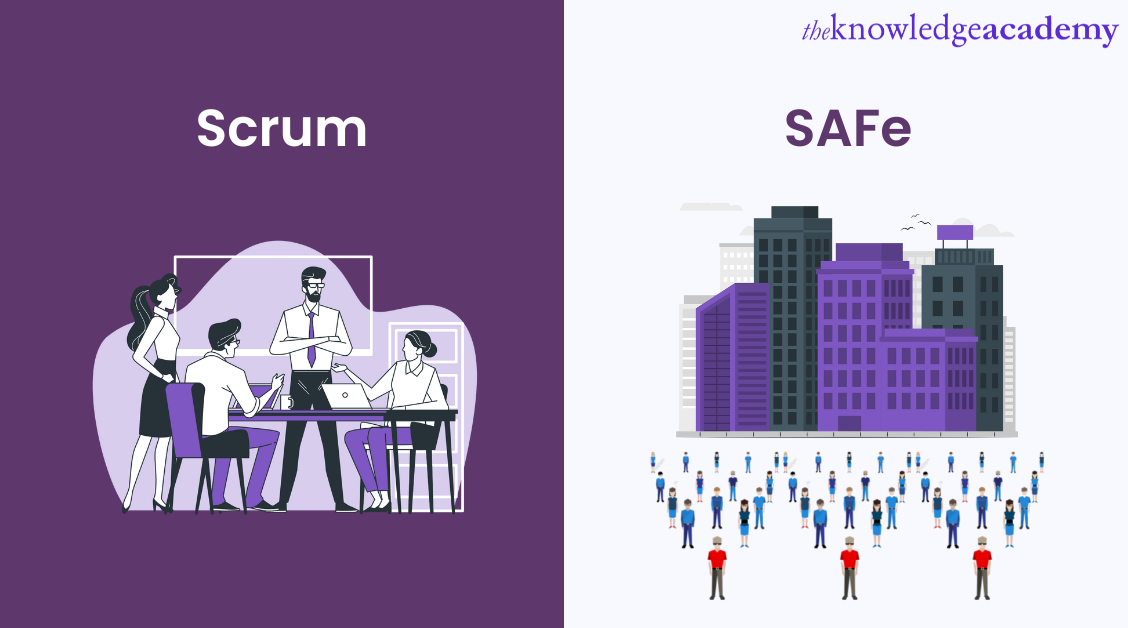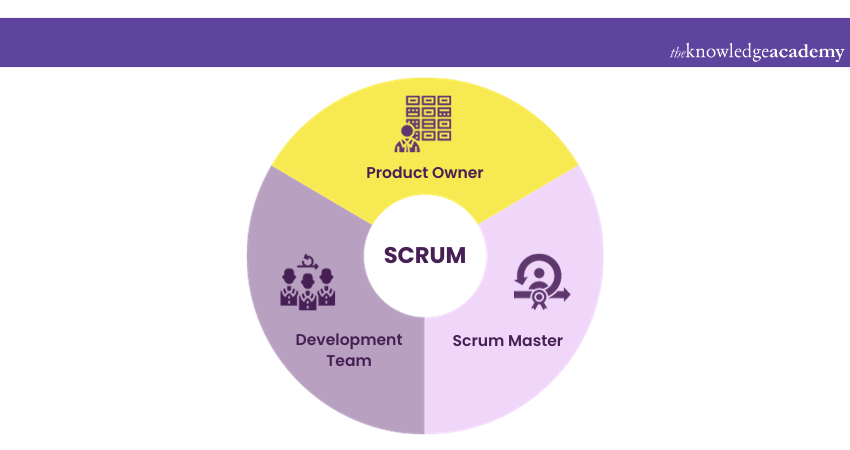We may not have the course you’re looking for. If you enquire or give us a call on +358 942454206 and speak to our training experts, we may still be able to help with your training requirements.
Training Outcomes Within Your Budget!
We ensure quality, budget-alignment, and timely delivery by our expert instructors.

Project management methodologies are tested out day-in, day-out in organisations worldwide to arrive at the most profitable solution. Amidst the plethora of methodologies available for organisations to adopt, a serious debate arises between them: SAFe vs Scrum.
Before heading to the debate of Scrum vs SAFe, it is pivotal that we understand what both mean. SAFe and Scrum are two frameworks widely used in software development for managing complex projects.
According to the official Scaled Agile Framework site, 70% of Fortune 500 companies worldwide have adopted SAFe in some manner. In contrast, according to a report from digital.ai, at least 66% of respondents in a survey have adopted Scrum into their operations.
While there are significant differences, it is always better to understand how both work before adopting either.
In this blog post on SAFe vs Scrum, you can learn more about the methodologies, the fundamental differences and the similarities between the both.
Table of Contents
1) Defining SAFe and Scrum:
a) SAFe
b) Scrum
2) What is difference between SAFe and Scrum?
3) Similarities between SAFe vs Scrum
4) Scrum vs SAFe: What should web developers choose?
5) Conclusion
Defining SAFe and Scrum
There are significant differences between Agile SAFe vs Scrum methodologies, making them have their respective use cases. However, they have their fair share of similarities as well. Hence it is always better to understand how both work before adopting either.
While both are Agile methodologies, they have key differences in their principles, practices, and scope.
a) SAFe:
Scaled Agile Framework (SAFe) is an Agile framework for managing large-scale projects with multiple teams, stakeholders, and dependencies. It provides a structured and scalable approach for aligning the development efforts of multiple teams towards a common goal while maintaining a continuous delivery pipeline and managing external dependencies.
SAFe is based on three primary pillars: Team, Program, and Portfolio, each with its own set of roles, events and artefacts:
1) At the Team level, SAFe guides how to organise and manage Agile teams using Scrum, Kanban, or a hybrid approach.
2) At the Program level, SAFe defines a set of practices for managing the flow of work across multiple teams, continuously integrating and validating the solution, and enabling faster feedback loops.
3) At the Portfolio level, SAFe guides how to align business strategy with development efforts, prioritise the work based on economic value and manage investment portfolios.
b) Scrum:

Scrum, on the other hand, is relatively lightweight and an iterative framework for managing small to medium-sized Software Development projects. It emphasises teamwork, collaboration, and iterative delivery of working software. Scrum is based on the principles of transparency, inspection and adaption. It also encourages frequent and open communication among team members, stakeholders, and customers.
Scrum consists of three primary roles:
1) The Product Owner prioritises the product backlog and ensures that the team is first working on the highest-value item.
2) The Scrum Master is responsible for facilitating the Scrum events, removing any impediments blocking the team's progress, and ensuring that the team follows the framework created based on Scrum.
3) The Development Team is responsible for delivering a potentially shippable product increment at the end of each sprint, typically lasting up to 4 weeks.
What is difference between SAFe and Scrum?
Elucidating on Scrum vs SAFe:
|
Basis of difference |
SAFe |
Scrum |
|
Definition |
SAFe is a scaled Agile framework designed for large organisations that require multiple teams to work on a single project. |
Scrum is a lightweight Agile framework that is used to manage and deliver software projects by a single team. |
|
Emphasis |
It emphasises a structured and prescriptive approach to Agile development that includes a set of predefined roles, processes and artefacts. |
It emphasises an iterative approach to Agile development that values collaboration and adaptability. |
|
Focus |
It includes a set of principles, practices and processes that focuses on software development, project management, and portfolio management. |
It focuses solely on software development and iterative delivery without addressing higher-level program or portfolio concerns. |
|
Additional processes involved |
It includes additional processes such as planning, system demos and workshops to facilitate collaboration across multiple teams. |
It includes auxiliary processes such as sprint planning, sprint reviews and workshops designed to facilitate transparency of the development process. |
|
Roles involved |
Product Manager, Release Train Manager, and Portfolio Manager are examples of predefined roles in the SAFe process. |
The predefined roles in the Scrum process are the Product Owner, the Scrum Master and the Development Team. |
|
Artefacts involved |
The SAFe includes a set of predefined artefacts, such as Program backlog, Solution backlog, and Release Train backlogs, designed to provide visibility and collaboration across multiple teams. |
Scrum includes a set of predefined artefacts, such as Product backlog and Sprint backlog, designed to provide transparency and progress tracking for the stakeholders. |
|
Metrics involved |
The predefined metrics involved in SAFe include Velocity, Business Value and Predictability. They allow the measure of performance and outcomes of large-scale Agile processes. |
The predefined metrics involved in Scrum include Sprint Goal and Sprint Burndown, designed to measure a single team's progress and effectiveness. |
|
Suitability |
Large-scale organisations, such as government agencies, banks and hospitals, require a high level of structure and governance. |
Scrum is more suitable for organisations that value flexibility, innovation and speed, such as software startups, creative agencies or digital product companies. |
Learn in-depth about the key responsibilities of a Scrum Master. Sign up with Scrum Master Certification now!
Similarities between SAFe vs Scrum
After discussing SAFe vs Scrum, it is key to point out that both methodologies have a fair bit in common. These similarities are:
1) Both are Agile methodologies that prioritise customer satisfaction and respond to change.
2) Both emphasise teamwork, collaboration, improvement and continuous communication.
3) Both seek continuous improvement in an attempt to deliver value incrementally and iteratively.
4) Both use feedback loops to inspect and adapt their processes and products.
5) Both encourage transparency and open communication between team members and stakeholders.
6) Both require active involvement from the Product Manager/Product Owner to ensure the Product Backlog is prioritised and aligned with the business goals.
7) Both focus on delivering a high-quality project/product that meets customer needs and expectations.
8) Both require a dedicated and well-empowered Scrum Master or Release Train Engineer to facilitate the team’s needs and remove obstacles.
9) Both use predefined metrics and measurements to track progress, identify inefficiencies, and improve performance.
10) Both are widely adopted and hailed by a large community of practitioners, trainers, and consultants.
Scrum vs SAFe: What should web developers choose?
When it comes to choosing between Scrum and Safe, factors such as the goal of a team and organisation matters a lot. Based upon such factors, one of the two methodologies might be more beneficial to a team than the rest. Some of these factors are as follows:
1) Size of the project: Size of the project can play a huge factor in deciding which framework is better.
a) Scrum: For relatively smaller web projects, Scrum is almost always considered a better option.
b) SAFe: On the other hand, SAFe is a better choice for large- scale projects, especially one with multiple teams working on it.
2) Team’s expertise: Teams expertise refers to how experienced the team is, be it in their work or with adaptation of methodologies. As a result, it is important to consider it before deciding on a framework.
a) SAFe: SAFe is well suited for a relatively less experienced team, that doesn’t have much experience with Agile methodologies.
b) Scrum: It is a better choice for an experienced team, who are ok with working by Agile methodologies, because of having done it in past.
3) Model maturity: Model maturity refers to how well a working model can integrate in a workplace over time.
a) SAFe: It is a complex model that needs a mature Agile environment to work properly, thus requiring time.
b) Scrum: On contrary, Scrum is much more user- friendly, making it more accessible. As a result, it is often considered a better choice for people and organisation new to Agile practices.
4) Delivery time: Delivery time refers to both established deadlines as well as over all time taken to finish work during a sprint. This makes it an important factor while choosing which methodology is more suited to your business.
a) SAFe: It is better suited for projects that are bound to take time. SAFe has the benefit of giving structure and necessary sustenance for the development taking place over time.
b) Scrum: is a great choice for projects with short deadlines. It is well suited for rapid iterations due to relatively short time boxed sprints.
5) Customers: Customers are the life blood of any organisation and how a methodology prioritises its customer can affect how well it is integrated.
a) SAFe: It prioritises coherent business goals, bringing structure to the business.
b) Scrum: It prioritises collaboration with customers, making it much more adaptable. As a result, it is more likely to respond to the changes in requirements and adapt accordingly if need be.
Conclusion
SAFe and Scrum are both methodologies organisations adopt to make their operations and business processes effective and efficient. However, in the debate of Scrum vs SAFe, there is no clear winner, as organisations adopt any of the two based on what the project demands of them.
In this blog, we hope that you understood what SAFe and Scrum are, the key differences between SAFe vs Scrum, and the similarities they both hold in common.
Better understand the roles and responsibilities within a Scrum team with Scrum For Teams. Sign up now!
Upcoming Project Management Resources Batches & Dates
Date
 Scrum Master Certification
Scrum Master Certification
Thu 2nd Jan 2025
Thu 9th Jan 2025
Thu 16th Jan 2025
Thu 23rd Jan 2025
Thu 30th Jan 2025
Thu 6th Feb 2025
Thu 13th Feb 2025
Thu 20th Feb 2025
Thu 27th Feb 2025
Thu 6th Mar 2025
Thu 13th Mar 2025
Thu 20th Mar 2025
Thu 27th Mar 2025
Thu 3rd Apr 2025
Thu 1st May 2025
Thu 22nd May 2025
Thu 5th Jun 2025
Thu 19th Jun 2025
Thu 3rd Jul 2025
Thu 17th Jul 2025
Thu 31st Jul 2025
Thu 14th Aug 2025
Thu 11th Sep 2025
Thu 25th Sep 2025
Thu 2nd Oct 2025
Thu 9th Oct 2025
Thu 16th Oct 2025
Thu 23rd Oct 2025
Thu 30th Oct 2025
Thu 6th Nov 2025
Thu 13th Nov 2025
Thu 20th Nov 2025
Thu 27th Nov 2025
Thu 4th Dec 2025
Thu 11th Dec 2025
Thu 18th Dec 2025







 Top Rated Course
Top Rated Course



 If you wish to make any changes to your course, please
If you wish to make any changes to your course, please


